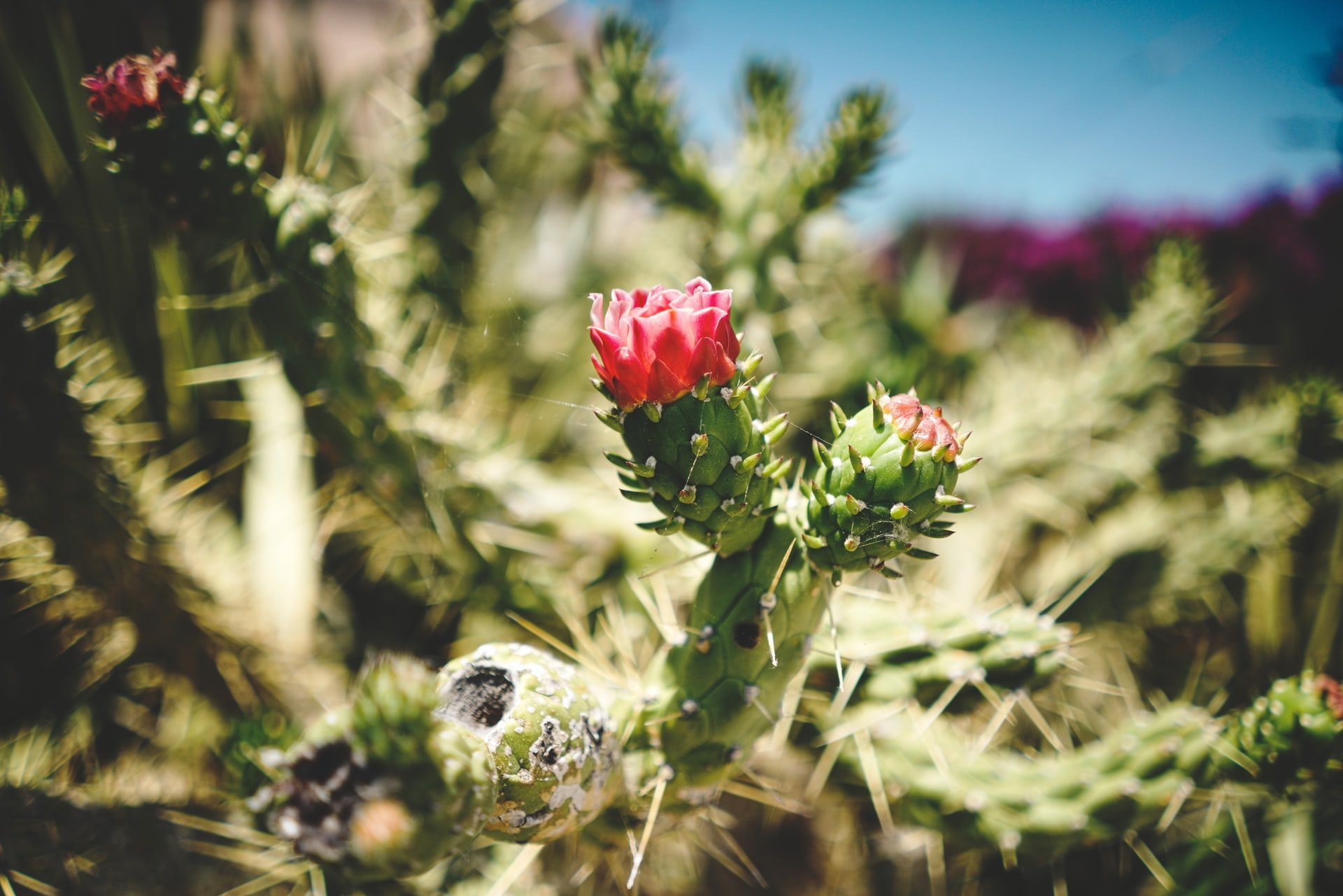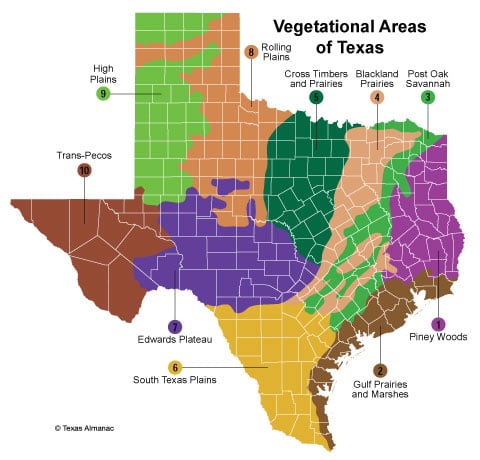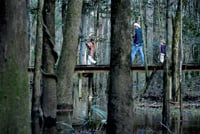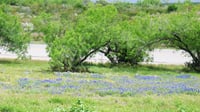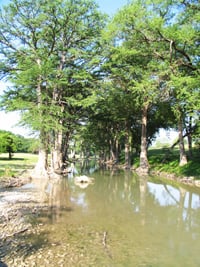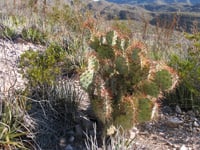The types of plants found in Texas vary widely from one region to the next. This is due to the amount and frequency of rainfall, diversity of soils, and the number of frost-free days. From the forests of East Texas to the deserts of West Texas, from the grassy plains of North Texas to the semi-arid brushlands of South Texas, plant species change continuously.
More than 100 million acres of Texas are devoted to grazing, both for domestic and wild animals. This is the largest single use of land in the state. More than 80 percent of the acreage is devoted to range in the Edwards Plateau, Cross Timbers and Prairies, South Texas Plains, and Trans-Pecos Mountains and Basins.
The 10 principal plant life areas of Texas, starting in the east, are:
1. Piney Woods
Most of this area of some 16 million acres ranges from about 50 to 700 feet above sea level and receives 40 to 56 inches of rain yearly. Many rivers, creeks, and bayous drain the region. Nearly all of Texas’ commercial timber comes from this area. There are three native species of pine, the principal timber: longleaf, shortleaf, and loblolly. An introduced species, the slash pine, also is widely grown. Hardwoods include oaks, elm, hickory, magnolia, sweet and black gum, tupelo, and others.
The area is interspersed with native and improved grasslands. Cattle are the primary grazing animals. Deer and quail are abundant in properly managed habitats. Primary forage plants, under proper grazing management, include species of bluestems, rossettegrass, panicums, paspalums, blackseed needlegrass, Canada and Virginia wildryes, purpletop, broadleaf and spike woodoats, switchcane, lovegrasses, indiangrass, and numerous legume species.
Highly disturbed areas have understory and overstory of undesirable woody plants that suppress growth of pine and desirable grasses. The primary forage grasses have been reduced, and the grasslands have been invaded by threeawns, annual grasses, weeds, broomsedge bluestem, red lovegrass, and shrubby woody species.
2. Gulf Prairies and Marshes
The Gulf Prairies and Marshes cover approximately 10 million acres. There are two subunits: (a) the marsh and salt grasses immediately at tidewater, and (b) a little farther inland, a strip of bluestems and tall grasses, with some gramas in the western part. Many of these grasses make excellent grazing.
Oaks, elm, and other hardwoods grow to some extent, especially along streams, and the area has some post oak and brushy extensions along its borders. Much of the Gulf Prairies is fertile farmland, and the area is well suited for cattle.
Principal grasses of the Gulf Prairies are tall bunchgrasses, including big bluestem, little bluestem, seacoast bluestem, indiangrass, eastern gamagrass, Texas wintergrass, switchgrass, and gulf cordgrass. Saltgrass occurs on moist saline sites.
Heavy grazing has changed the native vegetation in many cases so the predominant grasses are the less desirable broomsedge bluestem, smutgrass, threeawns, tumblegrass, and many other inferior grasses. Other plants that have invaded the productive grasslands include oak underbrush, Macartney rose, huisache, mesquite, prickly pear, ragweed, bitter sneezeweed, broomweed, and others.
Vegetation of the Gulf Marshes consists primarily of sedges, bullrush, flat-sedges, beakrush and other rushes, smooth cordgrass, marshhay cordgrass, marsh millet, and maidencane. The marshes are grazed best during winter.
3. Post Oak Savannah
This secondary forest area, also called the Post Oak Belt, covers some 7 million acres. It is immediately west of the primary forest region, with less annual rainfall and a little higher elevation. Principal trees are post oak, blackjack oak, and elm. Pecans, walnuts, and other kinds of water-demanding trees grow along streams. The southwestern extension of this belt is often poorly defined, with large areas of prairie.
The upland soils are sandy and sandy loam, while the bottomlands are sandy loams and clays.
The original vegetation consisted mainly of little bluestem, big bluestem, indiangrass, switchgrass, purpletop, silver bluestem, Texas wintergrass, spike woodoats, longleaf woodoats, post oak, and blackjack oak. The area is still largely native or improved grasslands, with small farms located throughout. Intensive grazing has contributed to dense stands of a woody understory of yaupon, greenbriar, and oak brush.
Mesquite has become a serious problem. Good forage plants have been replaced by such plants as split-beard bluestem, red lovegrass, broomsedge bluestem, broomweed, bullnettle, and western ragweed.
4. Blackland Prairies
This area of about 12 million acres, while called a “prairie,” has much timber along the streams, including a variety of oaks, pecan, elm, bois d’arc, and mesquite. In its native state, it was largely a grassy plain — the first native grassland in the westward extension of the Southern Forest Region.
Most of this fertile area has been cultivated, and only small acreages of grassland remain in original vegetation. In heavily grazed pastures, the tall bunchgrass has been replaced by buffalograss, Texas grama, and other less productive grasses. Mesquite, lotebush, and other woody plants have invaded the grasslands.
The original grass vegetation includes big and little bluestem, indiangrass, switchgrass, sideoats grama, hairy grama, tall dropseed, Texas wintergrass, and buffalograss. Non-grass vegetation is largely legumes and composites.
5. Cross Timbers and Prairies
Approximately 15 million acres of alternating woodlands and prairies, often called the Western Cross Timbers, constitute this region. Sharp changes in the vegetational cover are associated with different soils and topography, but the grass composition is rather uniform.
The prairie grasses are big bluestem, little bluestem, indiangrass, switchgrass, Canada wildrye, sideoats grama, hairy grama, tall grama, tall dropseed, Texas wintergrass, blue grama, and buffalograss.
On Cross Timbers soils, the vegetation is composed of big bluestem, little bluestem, hooded windmillgrass, sand lovegrass, indiangrass, switchgrass, and many species of legumes. The woody vegetation includes shinnery, blackjack, post, and live oaks.
The entire area has been invaded heavily by woody brush plants of oaks, mesquite, juniper, and other unpalatable plants that furnish little forage for livestock.
6. South Texas Plains
South of San Antonio, between the coast and the Rio Grande, are some 21 million acres of subtropical dryland vegetation, consisting of small trees, shrubs, cactus, weeds, and grasses. The area is noteworthy for extensive brushlands and is known as the Brush Country, or the Spanish equivalents of chaparral or monte. Principal plants are mesquite, small live oak, post oak, prickly pear (Opuntia) cactus, catclaw, blackbrush, whitebrush, guajillo, huisache, cenizo, and others that often grow very densely.
The original vegetation was mainly perennial warm-season bunchgrasses in savannahs of post oak, live oak, and mesquite. Other brush species form dense thickets on the ridges and along streams. Long-continued grazing has contributed to the dense cover of brush. Most of the desirable grasses have only persisted under the protection of brush and cacti.
There are distinct differences in the original plant communities on various soils. Dominant grasses on the sandy loam soils are seacoast bluestem, bristlegrass, paspalum, windmillgrass, silver bluestem, big sandbur, and tanglehead.
Dominant grasses on the clay and clay loams are silver bluestem, Arizona cottontop, buffalograss, common curlymesquite, bristlegrass, pappusgrass, gramas, plains lovegrass, Texas cupgrass, vinemesquite, other panicums, and Texas wintergrass.
Low saline areas are characterized by gulf cordgrass, saltgrass, alkali sacaton, and switchgrass. In the post oak and live oak savannahs, the grasses are mainly seacoast bluestem, indiangrass, switchgrass, crinkleawn, paspalums, and panicums. Today much of the area has been reseeded to buffelgrass.
7. Edwards Plateau
These 25 million acres are rolling to mountainous, with woodlands in the eastern part and grassy prairies in the west. There is a good deal of brushy growth in the central and eastern areas. The combination of grasses, weeds, and small trees is ideal for cattle, sheep, goats, deer, and wild turkey.
This limestone-based area is characterized by the large number of springfed, perennially flowing streams that originate in its interior and flow across the Balcones Escarpment, which bounds it on the south and east. The soils are shallow, ranging from sands to clays, and are calcareous in reaction. This area is predominantly rangeland, with cultivation confined to the deeper soils.
In the east-central portion is the well-marked Central or Llano Basin, centering in Mason, Llano, and Burnet counties, with a mixture of granitic and sandy soils. The western portion of the area comprises the semi-arid Stockton Plateau.
Noteworthy is the growth of cypress along the perennially flowing streams. Separated by many miles from the cypress growth of the moist Southern Forest Belt, they constitute one of Texas’ several “islands” of vegetation.
These trees, which grow to stately proportions, were commercialized in the past.
The principal grasses of the clay soils are cane bluestem, silver bluestem, little bluestem, sideoats grama, hairy grama, indiangrass, common curlymesquite, buffalograss, fall witchgrass, plains lovegrass, wildryes, and Texas wintergrass.
The rocky areas support tall or mid-grasses with an overstory of live oak, shinnery oak, juniper, and mesquite.
The heavy clay soils have a mixture of tobosagrass, buffalograss, sideoats grama, and mesquite.
Throughout the Edwards Plateau, live oak, shinnery oak, mesquite, and juniper dominate the woody vegetation. Woody plants have invaded to the degree that they must be controlled before range forage plants can re-establish.
8. Rolling Plains
This is a region of approximately 24 million acres of alternating woodlands and prairies. The area is half mesquite woodland and half prairie. Mesquite trees have steadily invaded and increased in the grasslands for many years, despite constant control efforts.
Soils range from coarse sands along outwash terraces adjacent to streams to tight or compact clays on redbed clays and shales. Rough broken lands on steep slopes are found in the western portion. About two-thirds of the area is rangeland, but cultivation is important in certain localities.
The original vegetation includes big, little, sand and silver bluestems, Texas wintergrass, indiangrass, switchgrass, sideoats and blue gramas, wildryes, tobosagrass, and buffalograss on the clay soils.
The sandy soils support tall bunchgrasses, mainly sand bluestem. Sand shinnery oak, sand sagebrush, and mesquite are the dominant woody plants.
Continued heavy grazing contributes to the increase in woody plants, low-value grasses such as red grama, red lovegrass, tumblegrass, gummy lovegrass, Texas grama, sand dropseed, and sandbur, with western ragweed, croton, and many other weedy forbs. Yucca is a problem plant on certain rangelands.
9. High Plains
The High Plains, some 19 million treeless acres, are an extension of the Great Plains to the north. Its level nature and porous soils prevent drainage over wide areas.
The relatively light rainfall flows into the numerous shallow “playa” lakes or sinks into the ground to feed the great underground aquifer that is the source of water for the countless wells that irrigate the surface of the plains. A large part of this area is under irrigated farming, but native grassland remains in about one-half of the High Plains.
Blue grama and buffalograss comprise the principal vegetation on the clay and clay loam “hardland” soils. Important grasses on the sandy loam “sandy land” soils are little bluestem, western wheatgrass, indiangrass, switchgrass, and sand reedgrass. Sand shinnery oak, sand sagebrush, mesquite, and yucca are conspicuous invading brushy plants.
10. Trans-Pecos Mountains and Basins
With as little as eight inches of annual rainfall, long hot summers, and usually cloudless skies to encourage evaporation, this 18-million-acre area produces only drought-resistant vegetation without irrigation. Grass is usually short and sparse.
The principal vegetation consists of lechuguilla, ocotillo, yucca, cenizo, prickly pear, and other arid land plants. In the more arid areas, gyp and chino grama, and tobosagrass prevail. There is some mesquite. The vegetation includes creosote-tarbush, desert shrub, grama grassland, yucca and juniper savannahs, pine oak forest, and saline flats.
The mountains are 3,000 to 8,749 feet in elevation and support piñon pine, juniper, and some ponderosa pine and other forest vegetation on a few of the higher slopes.
The grass vegetation, especially on the higher mountain slopes, includes many southwestern and Rocky Mountain species not present elsewhere in Texas. On the desert flats, black grama, burrograss, and fluffgrass are frequent.
More productive sites have numerous species of grama, muhly, Arizona cottontop, dropseed, and perennial threeawn grasses. At the higher elevations, plains bristlegrass, little bluestem, Texas bluestem, sideoats grama, chino grama, blue grama, piñon ricegrass, wolftail, and several species of needlegrass are frequent.
The common invaders on all depleted ranges are woody plants, burrograss, fluffgrass, hairy erioneuron, ear muhly, sand muhly, red grama, broom snakeweed, croton, cacti, and several poisonous plants.
For Further Reading
Hatch, S.L., K.N. Gandhi, and L.E. Brown, Checklist of the Vascular Plants of Texas; MP1655, Texas Agricultural Experiment Station, College Station, 1990.

